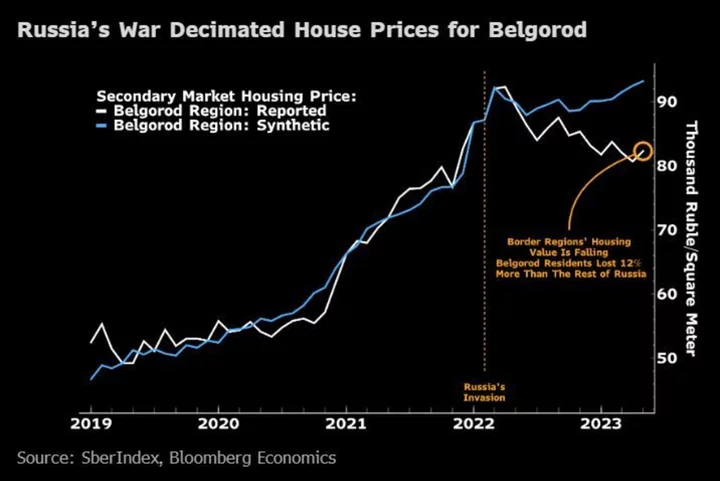President Vladimir Putin’s invasion of Ukraine has cost Russia tens of billions of dollars as sanctions squeeze its economy and government revenue slumps. Now with the conflict crossing into Russian territory, the price of war is likely to grow even further.
The damage pales in comparison to the enormous loss of life and economic devastation that Russia has inflicted upon Ukraine. Still, an outbreak of full-scale hostilities in regions bordering Ukraine may cut Russia’s already meager growth forecast to 0.8% in 2023, according to Bloomberg Economics estimates.
Belgorod region has repeatedly come under fire and faced incursions from Ukraine by fighters who’ve engaged in lengthy battles with Russian troops. Drone strikes have been reported in cities including Kursk, Krasnodar and Voronezh in addition to the large-scale attack that targeted Moscow last month.
“Everyone who is close to the war zone is leaving or thinking about it,” said Evgeny Gontmakher, an economist and former government official. “These are long-term effects — even with a favorable turn of events, people are unlikely to return quickly.”
Thousands of people in Belgorod region have moved to temporary shelters to escape the mounting violence or have been transferred to other parts of the country by local officials. In the town of Shebekino, home to a well-known pasta producer in Russia, officials promised financial aid to local factories that were forced to halt work as employees fled.
Shelling Kills Two in Russia’s Belgorod Region, Governor Says
With border regions home to a 10th of the country’s 143 million population, an outbreak of full-scale hostilities would start to impact on Russia’s economic growth as soon as the third quarter, according to Bloomberg Economics.
The Bank of Russia sees the economy growing as much as 2% this year and to reach pre-war levels by the end of 2024 as the impact of sanctions fades, while the Economy Ministry expects gross domestic product to rise by more than 1%. Russia’s annual GDP decline slowed for the third quarter in succession to minus 1.9% in the first three months of this year.
What Bloomberg Economics Says...
“As the conflict escalates into the summer, we expect Russia’s economic recovery to face increasing headwinds as consumer confidence and incomes in a greater number of war-adjacent regions follow the trend seen in Belgorod.”
—Alexander Isakov, Russia economist. For more, click here
As much as 1.7% of Russia’s household consumption may be directly affected if hostilities spread to the regions of Belgorod, Kursk and Bryansk, according to Tatiana Orlova, economist at Oxford Economics.
Increased turmoil in border regions would shift local economies from development to a focus on survival, while migration of residents away from the fighting and damage to infrastructure would add to the costs, said Natalya Zubarevich, a specialist on Russia’s regions at Moscow State University.
“Taken together, it’s an unpleasant picture,” she said.

